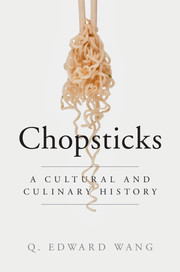Book contents
- Frontmatter
- Dedication
- Contents
- Acknowledgments
- List of Plates
- Timeline
- Map of East Asia
- 1 Introduction
- 2 Why chopsticks? Their origin and original function
- 3 Dish, rice or noodle? The changing use of chopsticks
- 4 Forming a chopsticks cultural sphere: Vietnam, Japan, Korea and beyond
- 5 Using chopsticks: customs, manners and etiquette
- 6 A pair inseparable: chopsticks as gift, metaphor and symbol
- 7 “Bridging” food cultures in the world
- Conclusion
- Glossary
- Bibliography
- Index
- Plate section
- References
2 - Why chopsticks? Their origin and original function
Published online by Cambridge University Press: 05 February 2015
- Frontmatter
- Dedication
- Contents
- Acknowledgments
- List of Plates
- Timeline
- Map of East Asia
- 1 Introduction
- 2 Why chopsticks? Their origin and original function
- 3 Dish, rice or noodle? The changing use of chopsticks
- 4 Forming a chopsticks cultural sphere: Vietnam, Japan, Korea and beyond
- 5 Using chopsticks: customs, manners and etiquette
- 6 A pair inseparable: chopsticks as gift, metaphor and symbol
- 7 “Bridging” food cultures in the world
- Conclusion
- Glossary
- Bibliography
- Index
- Plate section
- References
Summary
If the stew be made with vegetables, chopsticks should be used; but not if there be no vegetables.
Do not use chopsticks in eating millet.
Classic of Rites (Liji)On April 5, 1993, an archaeological team from the Institute of Archaeology of the Chinese Academy of Social Sciences launched a series of excavations of Neolithic ruins in Longqiuzhuang in present-day Gaoyou, Jiangsu. By December 1995, the team had completed its fourth and last dig of the 1,335-square-meter site. From the ruins, dated between 6600 and 5500 bce, they unearthed over 2,000 objects, mostly tools and utensils made of animal bones. Hailed as one of the ten new archaeological discoveries of 1993, what distinguished this excavation from other archaeological discoveries in Neolithic China was that forty-two bone sticks were uncovered from the site – these sticks, Chinese scholars believe, were the earliest chopsticks (Plates 2 and 3)!
Were they really chopsticks? What did they look like? According to the team’s report, these objects were between 9.2 and 18.5 cm in length and 0.3–0.9 cm in diameter. The sticks were thicker in the middle, with a square-shaped top, and their bottom tapered off into a point. Though coarse, their appearance does indeed resemble chopsticks used today. However, similar bone sticks had been found at other Neolithic sites, and scholars generally regarded them as hairpins. In fact, the Longqiuzhuang excavation originally ruled that the bone sticks were to be classified in this fashion.
- Type
- Chapter
- Information
- ChopsticksA Cultural and Culinary History, pp. 16 - 40Publisher: Cambridge University PressPrint publication year: 2015



